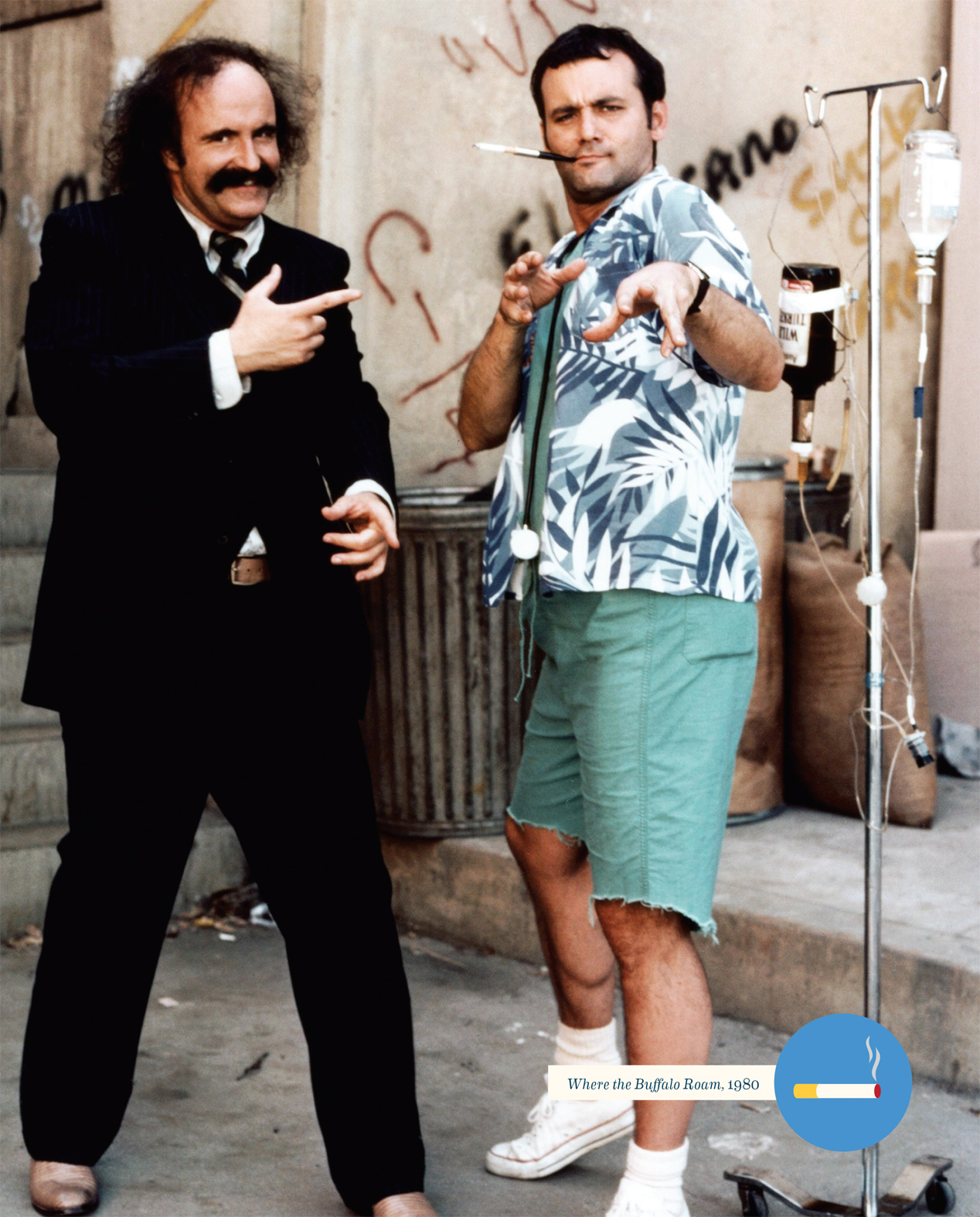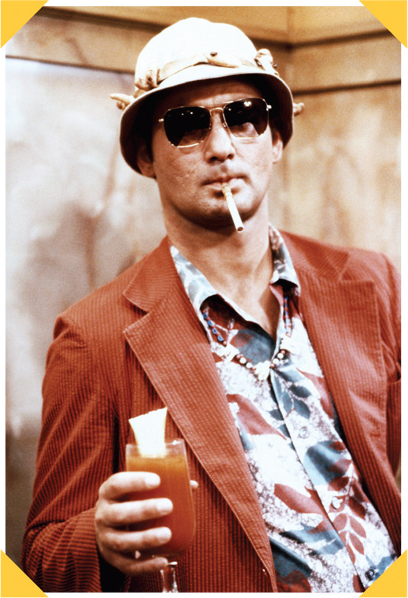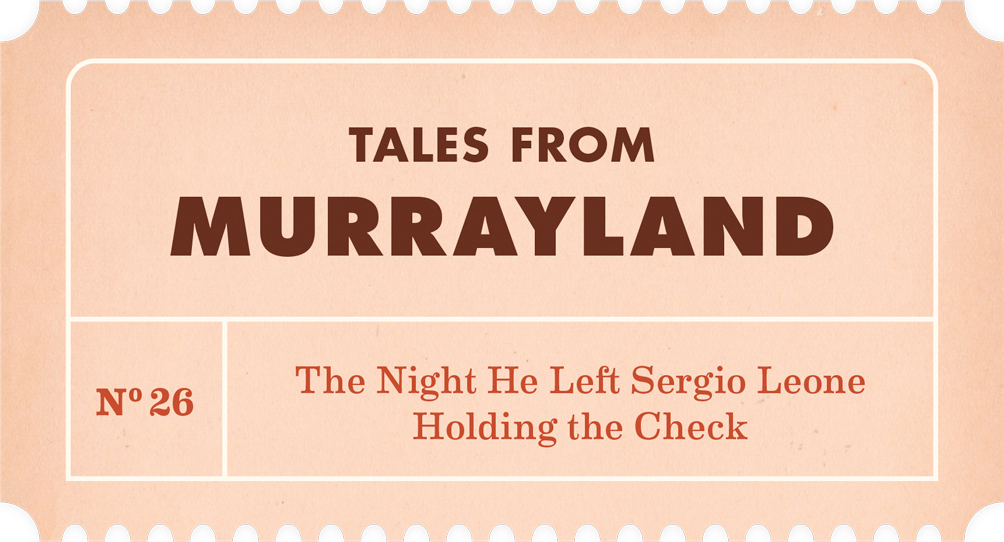
WAR OF THE INSECT GODS, THE
Unmade 1978 film project in which Murray was slated to star as Deadly Ed, an exterminator defending New York City from an invasion by giant cockroaches. War of the Insect Gods was the brainchild of maverick Saturday Night Live writer Michael O’Donoghue, who envisioned it as his directorial debut. O’Donoghue coauthored the screenplay with National Lampoon Radio Hour veteran Emily Prager, journalist and Murray pal Mitch Glazer, and novelist Dirk Wittenborn. From the start, O’Donoghue zeroed in on Murray for the lead role of Deadly Ed, the remorseless bug killer who figures out how to destroy the mutant bone-crushing roaches using bottles of ether. “Billy is who I want to play Deadly Ed,” O’Donoghue gushed. “He’s both a romantic lead and he’s a little sleazy. He looks like that exterminator kind of guy. And yet he’s a guy who can take on heroic proportions and look like an attractive American hero.” Unfortunately for Murray, this proto-Ghostbusters star turn was not to be. NBC passed on O’Donoghue’s pitch for a War of the Insect Gods TV movie. “Mr. Mike” then tried to raise money for a proposed theatrical version, but investors were put off by his demand that the film be shot in black and white and mortified by his habit of photocopying the corpses of squashed roaches into the pages of his script. When the film failed to acquire backing, O’Donoghue turned his attention to a new project, Mr. Mike’s Mondo Video.
“JOHN’S HUMOR WAS NOT DOOFUSY LIKE BILL MURRAY’S.”
WATERS, JOHN
Mustachioed gay cult filmmaker who reluctantly allowed Murray to sing the “love theme” to his 1981 comedy Polyester. Murray’s friend Chris Stein of Blondie recommended him for the gig, a suggestion the film’s producers were eager to accept in the wake of Caddyshack’s success the previous year. Murray agreed to perform for free on the track, “The Best Thing,” which was cowritten by Blondie frontwoman Debbie Harry. According to Polyester line producer Robert Maier in his book Low Budget Hell: Making Underground Movies with John Waters, Murray came into the studio in a T-shirt and baseball cap and nailed the song in two takes, with Harry supplying backup vocals. The only person who was not pleased with Murray’s performance was the notoriously prickly Waters. The outrageous auteur loathed Murray, whom he considered insufficiently edgy for his brand of envelope-pushing independent cinema. “He hated Bill Murray. He hated Saturday Night Live. He hated Caddyshack,” Maier wrote. “Murray was a mass-audience TV phenomenon, while John was an underground and dangerous artist… . John was angry, gay, and shocking, and he didn’t want it diluted.” Studio bosses overruled Waters, insisting on Murray’s participation as a way to generate buzz for a project with uncertain commercial prospects. (Polyester was presented in “Odorama,” an evolutionary form of Smell-O-Vision that allowed moviegoers to use scratch-and-sniff cards to huff the flatulence of the on-screen characters.) Waters never got over having Murray foisted upon him and refused to thank the actor for his contribution. In the end, Murray’s presence on the soundtrack did not generate the publicity producers had hoped it would. Polyester bombed at the box office and failed to launch Waters into the mainstream.
WEATHER CHANNEL, THE
This twenty-four-hour meteorological TV network is one of Murray’s destination cable channels. “I’ve been a weather watcher for years,” he told one interviewer. To a radio host, he confessed: “I was one of the first people to really devote my entire life to the Weather Channel.” He boasts that he watches the channel “all the time. There’s this guy from Wisconsin who’s almost my personal savior.” Murray prepared for his role as a TV weatherman in 1993’s Groundhog Day by watching the Weather Channel almost nonstop.

WHAT ABOUT BOB?
DIRECTED BY: Frank Oz
WRITTEN BY: Tom Schulman
RELEASE DATE: May 17, 1991
FILM RATING: ***
MURRAY RATING: ***
PLOT: A multiphobic loon enrages his psychiatrist.
STARRING BILL MURRAY AS: Bob Wiley, needy psychiatric patient
Playing against type as a man with no self-confidence and precious little charm, Murray delivers one of the finest performances of his career in this delightfully dark comedy directed by legendary Muppeteer Frank Oz. As Bob Wiley, a neurotic shut-in with staggering emotional needs, Murray persistently bedevils a pompous psychiatrist played by Richard Dreyfuss.
According to Murray, the oil-and-water rapport he developed with Dreyfuss had its basis in their off-camera relationship. “[Dreyfuss and I] didn’t get along on the movie,” he once admitted. “But it worked for the movie. I mean, I drove him nuts, and he encouraged me to drive him nuts.” Murray attributed the personality conflict to Dreyfuss’s disciplined, theatrical acting style, which clashed with Murray’s more freewheeling, improvisational approach. “He drove me nuts with his stage precision, so I returned the favor with anarchy,” Murray said. “That’s cinema verité you see up there.”
“IT’S ENTERTAINING—EVERYBODY KNOWS SOMEBODY LIKE THAT BOB GUY.”
Considering that the film climaxes with Dreyfuss’s character attempting to murder Bob by strapping dynamite to his chest, it is fortunate that the two actors managed to survive the experience. Apparently violent behavior was not unheard of on the What about Bob? set. When he wasn’t driving Richard Dreyfuss to distraction, Murray was picking fights with the film’s producer, Laura Ziskin. According to Ziskin, Murray “threatened to throw me across the parking lot and then broke my sunglasses and threw them across the parking lot.” When those love taps failed to elicit the desired response, Murray reportedly picked up Ziskin and tossed her into a lake in full view of the crew. “I was furious and outraged at the time,” Ziskin later recalled, “but having produced a dozen movies, I can safely say it is not common behavior.”
NEXT MOVIE: Groundhog Day (1993)

WHERE THE BUFFALO ROAM
DIRECTED BY: Art Linson
WRITTEN BY: John Kaye
RELEASE DATE: April 25, 1980
FILM RATING: ***
MURRAY RATING: ***
PLOT: Gonzo journalist Hunter S. Thompson drinks, smokes, and snorts his way through a series of magazine assignments in the 1970s.
STARRING BILL MURRAY AS: Hunter S. Thompson
Murray scored his first flop with this aimless 1980 comedy chronicling the exploits of gonzo journalist Hunter S. Thompson. Peter Boyle headlines the cast—inexplicably, considering he is in only a handful of scenes—as Carl Lazlo, a fictionalized version of Thompson’s lawyer and drug buddy Oscar Zeta Acosta (known to his intimates as the Brown Buffalo). As the hard-partying Thompson, Murray mumbles and shuffles and does a lot of actorly gesturing with his cigarette holder. If it were a three-minute Saturday Night Live impression, his performance would have been top-notch. Unfortunately the film goes on for an hour and a half.

Loosely based on Thompson’s 1977 magazine article “The Banshee Screams for Buffalo Meat,” Where the Buffalo Roam marks the directorial debut of Art Linson, producer of the lowbrow late-’70s hits Car Wash and American Hot Wax. The film was shot in and around Los Angeles over two months in the summer of 1979, just as Meatballs was blowing up at the box office. During filming, Thompson lived in a guest house underneath the swimming pool in Murray’s rented home in North Hollywood. “I’d work all day and stay up all night with him,” Murray remembered. “I was strong in those days.” To give him something to occupy his time, Thompson was kept on retainer as an “executive consultant” to the production—a gig he later said consisted of wandering around the set firing a machine gun.
“I WANTED TO DO SOME ESCAPE WORK. IT WAS SUMMERTIME. IT WAS HOT.”
Murray had reservations about the script from the beginning. The film seemed episodic and unfocused. As shooting commenced, he grew increasingly anxious that he had a turkey on his hands. He managed to convince Linson to allow him to rewrite entire scenes on the set with help from Thompson. The duo continued to revise until three days before the film’s release, adding narration they hoped would fill the myriad holes in the plot, as well as the dada monologue that buttons up the final scene.
None of their tweaks could render the movie’s slapdash plot coherent, however. When it opened in the spring of 1980, Where the Buffalo Roam was roasted by critics and shunned by audiences. Even Thompson disowned the film after seeing it. Writing about Where the Buffalo Roam for Rolling Stone, longtime Thompson associate David Felton called Murray’s portrayal “spooky and accurate.” But he dismissed the film as a hack job, “an embarrassing piece of hogwash utterly devoid of plot, form, movement, tension, humor, insight, logic, or purpose.”
Rarely shown on television and never given a proper DVD release, Where the Buffalo Roam seems consigned to the cut-out bin of history. Its only lasting legacy is the plethora of Bill Murray/Hunter Thompson party stories that have been disseminated over the ensuing decades. In the most famous, Murray and Thompson spend a day drinking and carousing at the latter’s ranch in Aspen, Colorado. They get into an argument over who is the better escape artist. Thompson ties Murray to a chair and throws him into his swimming pool. Murray almost drowns before Thompson fishes him out.
NEXT MOVIE: B.C. Rock (1980)
WHO FRAMED ROGER RABBIT?
Director Robert Zemeckis tried to offer Murray the role of Eddie Valiant in this 1988 comedy mixing live action and animation. The elusive actor proved impossible to track down, however, and the part went to Bob Hoskins instead. Murray has admitted that he regrets missing out on the gig.
WILD THINGS
DIRECTED BY: John McNaughton
WRITTEN BY: Stephen Peters
RELEASE DATE: March 20, 1998
FILM RATING: **
MURRAY RATING: **
PLOT: Two teenage sex kittens frame a high school guidance counselor for a crime he did not commit—or did he?
STARRING BILL MURRAY AS: Ken Bowden, sleazy South Florida lawyer
After headlining two stinkers in a row—Larger Than Life and The Man Who Knew Too Little—Murray returned to the safe harbor of scene-stealing character work in this high-gloss erotic thriller from Mad Dog and Glory director John McNaughton.
Like Cinemax softcore with a chewy Lifetime movie center, Wild Things sprays pheromones at the audience for nearly two hours to no discernible effect. It has garnered something of a cult following because of a steamy three-way sex scene featuring Matt Dillon, Denise Richards, and Neve Campbell—as well as a brief glimpse of Kevin Bacon’s schlong—but the film’s convoluted plot and some terrible performances undermine its effectiveness. Murray’s character, an ambulance-chasing lawyer who inexplicably wears a neck brace in half his scenes, was added by McNaughton to provide comic relief to the noir goings-on. It is one of many weird tonal shifts that do not serve the picture well.
Despite mixed reviews and lackluster box office returns, Wild Things spawned three straight-to-video sequels—none of which included Murray. By 2013, director McNaughton was musing publicly about a possible fourth sequel, set at the same Miami high school, revolving around the offspring of the original characters. “Maybe there is a child and maybe Bill Murray’s character had a child and they’re exchange students and things get out of hand,” he told Hollywood.com.
NEXT MOVIE: With Friends Like These … (1998)

One night in the 1980s, Murray was having dinner in a New York City restaurant with a group of friends, including Nothing Lasts Forever director Tom Schiller and legendary spaghetti western auteur Sergio Leone. Toward the end of the meal, at Schiller’s suggestion, Murray passed the word to the other diners to get up and leave the table one by one, as if they were going to use the restrooms. Then they would all meet outside and leave Leone with the check. “We were just a bunch of wise guys,” Murray told author Michael Streeter. “It was such a novel idea to try and catch a real movie guy and stick him with the bill.” Tom Schiller remembers Leone’s expression when he caught on to the gag: “Kind of like Eli Wallach’s look as Tuco during the duel at the end of The Good, the Bad, and the Ugly. Priceless.”
WILLIS, BRUCE
The Die Hard star worked with Murray on Moonrise Kingdom in 2012, but they had met much earlier. In the late 1970s, Willis worked as a page at NBC headquarters in New York City. His duties included refilling the M&M bowls in the dressing rooms of the Saturday Night Live cast members. Nearly thirty years later, Willis told Murray that he and Gilda Radner were the only two actors on the show who ever treated him “like a human being.”
WILMETTE, ILLINOIS
Suburban village fourteen miles north of Chicago where Murray grew up. Although Wilmette is often cited as his birthplace, in fact he was born in nearby Evanston. Incorporated in 1847, the village is home to the world’s oldest surviving Bahá’í House of Worship. Other notable Wilmettians include actor Charlton Heston, entertainer Ann-Margret, and Chicago mayor Rahm Emanuel.
“I REMEMBER SPENDING MY LAST DOLLAR ON SOME FRENCH FRIES, AND I JUST WANTED TO GET OUT OF WHERE I WAS.”
In his autobiography Cinderella Story, Murray described Wilmette as “a neighborhood of front lawns and sidewalks… . People had money there, but we weren’t among them.” Murray’s brother Andy once described it as “a fabulous place to be a kid.” The Murray home was located at 1930 Elmwood Avenue, a quiet, tree-lined street across from the Sisters of Christian Charity convent. “Our house was a wreck—a constant claustrophobic mess,” Murray once observed of the three-bedroom, 2,000-square-foot home where he and his eight siblings jockeyed for space.
WIRED IN
Unaired TV documentary series about the tech trends of the 1980s for which Murray contributed a bizarre antitechnology monologue. In the presumably improvised rant-to-camera, Murray rails against digital watches (“People have hands. Watches should have hands”), decries the advent of worker robots, denounces “talking dashboards” in cars, and extols the virtues of Kenny Baker, the “fine actor” who played R2-D2 in the Star Wars movies. Lily Tomlin also appears in the program—excerpts of which live forever on YouTube—playing a Pac-Man-addicted housewife in a parody of antidrug public service announcements.
WITCHES OF EASTWICK, THE
Murray was director George Miller’s first choice for the role of Daryl Van Horne in this 1987 dark comedy based on John Updike’s novel. But Murray was in the midst of his four-year sabbatical from Hollywood at the time. Jack Nicholson got the part instead.
WITH FRIENDS LIKE THESE …
DIRECTED BY: Philip Frank Messina
WRITTEN BY: Philip Frank Messina
RELEASE DATE: September 10, 1998
FILM RATING: **
MURRAY RATING: *
PLOT: Four small-time actors vie for a part in a Martin Scorsese movie.
STARRING BILL MURRAY AS: Maurice Melnick, cheese-hoarding Hollywood bigwig
Murray has a one-scene cameo as a penurious TV producer who steals cheese from people’s party platters in this obscure late-’90s curiosity, also known as Mom’s on the Roof. An inside-Hollywood comedy about four friends who find themselves at odds when they all are up for the same part in a new Martin Scorsese movie, With Friends Like These … played briefly on the festival circuit and then moldered on a shelf for seven years before resurfacing in theaters in 2005. Scorsese, Garry Marshall, and Michael McKean also have cameos in the film.
NEXT MOVIE: Rushmore (1998)
WOODWARD, BOB
Legendary journalist and coauthor of All the President’s Men. Murray despises Woodward for his depiction of John Belushi as a degenerate drug addict in the 1984 biography Wired. “I read that and said, ‘Holy shit, this Bob Woodward is a total fraud,’ Murray once said. “The people he interviewed for his story were all in the outer circle, four degrees of separation removed from John’s life and the truth.” In an interview, Murray accused Woodward of having a vendetta against his old Saturday Night Live costar. “Woodward had a mean bent from the beginning, and I know why,” he said. “Bob Woodward is jealous: he is only the third most famous person from Wheaton, Illinois. The first is John Belushi, the second is Red Grange, and the third is Bob Woodward. And Woodward is a distant third and is never going to get any closer.”
WORK
Before committing full-time to a show business career in the mid-1970s, Murray performed numerous odd jobs. As a young man, he hauled concrete blocks, sold hot dogs from a cart, and caddied at the Indian Hill Club in Winnetka, Illinois. He worked as a rod man on a surveying crew, a pizzaiolo at a Little Caesars, a landscaper, and a marijuana dealer. “I had no idea what I was going to do,” he once observed of his checkered work history. “I had trouble holding jobs because they want you to be on time. That wasn’t going to work.” The life of the theater appealed to him, he said, because “you didn’t have to get to work until nine o’clock at night.”
In many interviews, Murray has bemoaned his lack of a strong work ethic. As he has grown older, he claims, he has just gotten lazier. “Life interferes, you know. When you’re young and all you have is your career, some of your life can be in second place. And then you want your life to take first place, and other people don’t see it that way. They see it that your life has to take second place, and it’s hard. Life is really hard, and it’s the only one you have. I mean, I like doing what I do, and I know I’m supposed to do it, but I don’t have anything to bring to it if I don’t live my life.”
“I DO ABSOLUTELY NOTHING. I GO HOME AND STAY THERE. I WASH AND SCRUB UP EACH DAY, AND THAT’S IT. ONE MONTH I ACTUALLY GREW A MUSTACHE, JUST SO I COULD SAY THAT I’D DONE SOMETHING.”